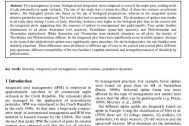Content
Two management systems, biological and integrated, were compared to control the major pest, codling moth (Cydia pomonella) in apple orchards. The aim of the study was to assess the effect of these two systems on arboreal spiders. The biological system was based on the use of biological preparations, whereas in the integrated system selective pesticides were employed. The control plot had no pesticide treatment. The abundance of spiders was similar in all study plots during 3 years of study. Diversity, however, was higher in the biological plot than in the control and the integrated plots, suggesting that the response of spiders to management was guild-specific. Four spider families dominanted in all plots: Araneidae (orb weavers), Theridiidae (space-web weavers), and Philodromidae and Thomisidae (ambushers). While Araneidae and Thomisidae were similarly abundant on all plots, the density of Theridiidae and Philodromidae differed. In the integrated plot there were significantly more theridiid spiders, whereas in the control plot philodromid spiders were significantly more abundant. On the biological plot, the two families were similarly abundant. These differences were attributed to different age of trees in the control and treated plots, different prey spectrum, different susceptibility of the two families to applied chemicals and intraguild predation of theridiids by philodromids.



